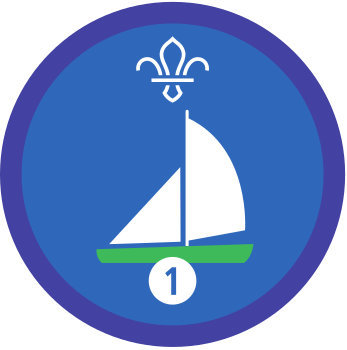
Wild wind
You’ll need
- Scrap paper
- Pens or pencils
- Scissors
- Craft materials (for example, tissue paper, pipe cleaners, stickers)
- Sticky tape
- Hair dryer or fan
Before you begin
- The activity’s in two parts, so you could run the different parts as separate bases or in different sessions, if this helps.
- Print off enough copies of the ‘Beaufort scale cards’ for everyone.
- Print off the same number of copies of Howtoon’s The Beaufort Scale, and cut out each image.
- They’ll need to work in pairs or small groups, so you’ll need one set of cards for each.
- Those working towards stage four of the Sailing Staged Activity Badge will need to complete this activity as well as Rules of the nautical road and When tides collide to meet the badge requirement.
Build your Beaufort scale
- Introduce everyone to the Beaufort scale using the information in the box below to help. Then, split into pairs or small groups and give each group a set of ‘Beaufort scale cards’ and shuffle them.
- Challenge the groups to match up their shuffled cards into columns and rows to make their own Beaufort scale. Match the Beaufort force number to the observed conditions at sea and land, and the image that shows these conditions.
- Check each group has a table matching the Beaufort scale and bring the groups together. Have them examine each row of the table and discuss the different things you might see happening under each set of conditions.
- When everyone has a clear idea of what each level of the scale might look like, run a quick game of 20 questions to see how much they’ve learned. Back in small groups, one person should choose a level from the scale. The others should take it in turn to ask questions and the first person can only respond with ‘yes’ or ‘no’. See how many questions it takes for the group to guess the correct level of the scale, then play again until everyone’s had a go.
- The scale was created in the early 19th century by Francis Beaufort, a Royal Navy Officer, as a measure that relates wind speed to the conditions you can see at sea or on land.
- The scale runs from 0 (calm) to 12 (hurricane) and originally only referred to wind conditions, instead of wind speed numbers. This included criteria like wave height and a description of the water surface.
- You can find more information about the scale from the Met Office website.
- Have a look at Forecast enthusiast to learn all about synoptic weather charts and how they show the wind.
Make a mini model
- Split into groups of three or four people. Give each groups craft materials and a hairdryer or fan.
- Challenge the groups to make a model that demonstrates the Beaufort scale. Encourage everyone to be creative and use the information on the table they made earlier to help.
- Once groups have finished their models, it’s time to test them. Take it in turns to use a hair dryer, or a fan, to create a wind effect on the model.
- See if groups can match up their model to a number on the Beaufort scale, based on the effects they can see.
Reflection
This activity relied on groups working together well. Ask everyone to think about the first part of the activity and the discussion. How did everyone agree on the right order for their scale, and if they didn’t, ask them how they settled on an order to run with moving forwards. Communicating with each other is a big part of working in a team, and it’s really important to make sure you listen to everyone’s opinion and work out the best way forward together.
Next time you’re out on a walk, or on the water sailing, remember to think about the wind too! Challenge everyone to try and remember what they’ve learned in the session and see who can say what level you’re witnessing from the Beaufort wind force scale.
Safety
All activities must be safely managed. You must complete a thorough risk assessment and take appropriate steps to reduce risk. Use the safety checklist to help you plan and risk assess your activity. Always get approval for the activity, and have suitable supervision and an InTouch process.
- Scissors
Supervise young people appropriately when they’re using scissors. Store all sharp objects securely, out of the reach of young people.
- Rubbish and recycling
All items should be clean and suitable for this activity.
For a simpler activity, swap out the model making and draw some images instead. Why not draw somewhere familiar, like your meeting place, and draw some images of how it might look at the different levels of the Beaufort scale?
You could change up the 20 questions game and play a game of Pictionary, or try a game of charades, where groups can mime what they’d be doing on a boat, or how the trees would be moving under different conditions.
All Scout activities should be inclusive and accessible.
Interested in learning more about the weather? Have a look at the Scouts Meteorologist Activity Badge.
